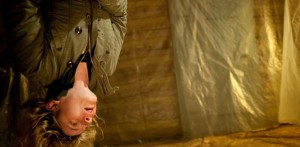A Horrible Way to Die is in about Sarah (Amy Seimetz), a recovering alcoholic, trying to rebuild her life in a new town unaware that her ex-boyfriend Garrick (The House of the Devil’s AJ Bowen), a convicted serial killer, has escaped prison and is slowly making his way back to her. Its plot might not seem that unusual for a horror film but its presentation is less traditional.
When talking about the inspirations that shaped his film director Adam Wingard references the mumblecore movement. Its influence is evident in his haphazard visual style, the actors’ use of improvisation, the low budget sheen and the heavy use of Christmas lights. The presence of Seimetz (Tiny Furniture, The Off Hours) and Joe Swanberg (LOL, Nights and Weekends, Uncle Kent) doesn’t hurt either.
While mumblecore and horror might seem like an odd marriage A Horrible Way to Die was never intended to be a traditional horror film. From its use of extended takes, a technique Wingard settled upon while watching Lars von Trier’s Breaking the Waves, to its amiable psychopath, A Horrible Way to Die was meant to be something different. But even longtime collaborator Simon Barrett, who has written the majority of Wingard’s films, wasn’t interested in writing a screenplay about a serial killer. It wasn’t until Wingard pointed out the particulars of Ted Bundy’s life, his charming persona and multiple escapes, that Barrett agreed and the script came quickly after.
Using Bundy as a loose model Barrett has created a killer that is atypical in that he is personable and intelligent. A killer that suffers for the things he is compelled to do but continues to give in to his compulsions nonetheless. Giving a sense of humanity to a monster is risky but ultimately it makes for a much more interesting character.
The film’s narrative is told out of sequence, but Wingard insists it was never intended to feel random. The rough cinematography, which was all shot handheld by Wingard, the choppy editing and the ordering of the scenes, although slightly changed during the editing process when a scene was cut, was decided upon prior to shooting. This doesn’t make the film feel like it is comprised of found footage; it makes the audience a witness and at times a participant.
Despite its lofty goals A Horrible Way to Die isn’t always effective. The mumblecore elements are done well but the horror aspect is never as menacing as it should be. The film’s ending, which features a considerable twist, doesn’t have the impact that it should. This is partly because I never felt an attachment to any of the characters. Still, mumblecore fans should find plenty to feast upon. Horror fanatics will want to approach A Horrible Way to Die with fewer expectations.
